How can the judicial system of India be improved?
The article 'How can the judicial system of India be improved?' emphasises about the judicial system of India and several areas where it could be improved.

The article 'How can the judicial system of India be improved?' emphasises about the judicial system of India and several areas where it could be improved. The judicial system of India is a complex network of courts that operate at the national, state and local levels. It is based on the principles of British common law and the Constitution of India, which outlines the powers and responsibilities of the judiciary.
Judicial System of India
The judicial system in India is divided into three main categories:
Supreme Court of India: It is the highest court in the country and is located in New Delhi. The Supreme Court has the power of judicial review and can strike down any law passed by the Parliament or state legislatures if it is found to be unconstitutional. It also has appellate jurisdiction over all other courts in the country.
High Courts: Each state in India has a high court, which has jurisdiction over that particular state. The high courts are the final courts of appeal for cases that originate in lower courts within their jurisdiction. They also have original jurisdiction in some cases.
Lower Courts: The lower courts in India consist of district courts, which are located in each district, and subordinate courts, which are located in towns and cities. These courts have original jurisdiction over criminal and civil cases within their jurisdiction.
In addition to these courts, various tribunals and commissions are established to deal with specific areas of law, such as labour disputes, taxation, and human rights.
Here are some potential ways to improve the judicial system in India:
Reduce Case Backlogs: The Indian judicial system has a large number of pending cases, which can lead to delays in justice delivery. There is a need to improve the efficiency of courts, increase the number of judges and support staff, and explore the use of technology to help expedite the process.
Enhance Judicial Infrastructure: There is a need to invest in judicial infrastructure, including the construction of new courts, the modernization of existing facilities, and the deployment of technology to help streamline processes.
Increase in Judicial Accountability: The Indian judiciary is known for its independence, but there is a need to increase accountability. One way to do this is to establish a system for monitoring judges' performance, including regular evaluations and assessments.
Strengthen Legal Education: Improving the quality of legal education can help produce better lawyers, judges, and legal professionals. This includes updating the curriculum, improving teaching methods, and increasing funding for legal education.
Explore Alternative Dispute Resolution Mechanisms: Traditional court systems can be slow and expensive, and there is a need to explore alternative dispute resolution mechanisms such as arbitration, mediation, and conciliation. This can help reduce the burden on courts and provide faster resolution to disputes.
Improve Access to Justice: Access to justice is a critical issue in India, particularly for marginalized communities. There is a need to increase legal aid, provide legal services in local languages, and increase awareness of legal rights and entitlements.
Overall, there is a need for a comprehensive approach to improving the Indian judicial system, which involves increasing efficiency, accountability, infrastructure, education, and access to justice.
Important Links
Law Library: Notes and Study Material for LLB, LLM, Judiciary, and Entrance Exams

